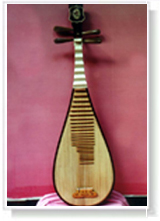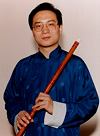
::
musicians
::
events
::
booking
::
learning
::
traditions
::
photo gallery
::
samples (audio)
::
samples (video)
::
store
::
links
::
donation
::
contact us


Chen Tao (Director)
Melody of Dragon, Inc.
53-19 195th Street
Fresh Meadows, NY
11365
Tel: 347-259-9252
Email

|
|
Pipa

>>
Pipa is a plucking stringed instrument. According to the Shiming by Liu Xi in the West Han dynasty: "Pipa came from the land of the barbarians. It was an instrument played on the horse. It sounds like 'pi' when the strings are pushed forward, and 'pa' when the strings are pulled back. Thus it was so named." So the name of "pipa" originates from its sound; the two characters were later changed into pipa. Pipa was a generic term for musical instruments from the period of Qin (221-207 BC) and Han (206 BC-220 AD) to Sui (581-618 AD) and Tang (618-907 AD).
Ever since the culture exchange with Xiyu ( the western region ) in the fourth century, there appeared in the mainland a kind of pipa having a semi-pear-shaped sound box and curved neck. It was played horizontally in front of the chest with either a pick or the fingers. Some of these pipa were four-stringed, and some five. With the continuous improvement of these tow types of pipa since the Tang (618-960 AD) and Song (960-1368 AD)dynasties, the instrument finally came into its present form with the semi-pear-shaped sound box, thin phoenix wood cover, back curving neck, a pole with four xiang (frets in the upper part), a surface with nine to thirteen pin (frets in the lower part), and four strings played by the fingers or artificial finger nails.
The timbre of pipa is bright and clear. It is commonly used to accompany singing, folk arts, theatrical music, orchestra, instrumental ensemble and solo.
<<sample
music>>
|
home :: email
|
|

|




explore & learn more about the Chinese music traditions.

Click here, to hear the
music samples.


meet our musicians.

copyright 2004, by melody of dragon.

|
|

